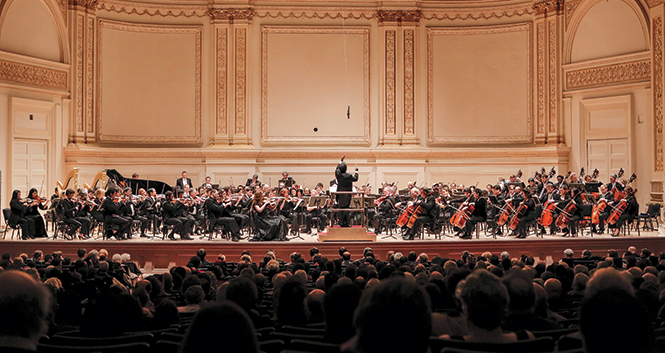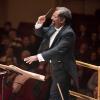How a 1941 symphony tells the story of today’s conflict in Syria.
Carnegie Hall, January 2006. George Mathew ’91, conducting Beethoven’s Ninth Symphony, glanced into the string section. His undergraduate adviser, Jenny Kallick, the teacher who’d first suggested he consider becoming a conductor, was playing the cello. Her presence was a reminder that they were doing something unusual. Kallick, along with every other musician on stage, was a volunteer. The concert was being put on by Mathew’s nascent organization, Music for Life International—and it turned out to be the first of many.

At Carnegie Hall, Mathew conducted Shostakovich’s Seventh Symphony.
Mathew was a student at Hampshire College when he first met Kallick. In addition to plowing through all the course offerings for orchestra at Hampshire, he took several courses at Amherst. “Professor Kallick packed me off to a summer program at Tanglewood,” he says. Exposed to all the workings of the orchestra (and, crucially, to the great Leonard Bernstein, who took a shine to the young student), Mathew returned ready to delve seriously into conducting—and to transfer to Amherst. “Mr. Bernstein never hesitated to remind us that music is best when understood outside itself,” Mathew says. “That’s the fantastic thing about the liberal arts approach—it’s always exploring from another perspective.”
Fifteen years later Mathew—by then a staff conductor at the Manhattan School of Music—was watching the world around him crumble. First there was the tsunami in Southeast Asia, then Hurricane Katrina. “And there was an earthquake in Pakistan, in the region right on the Indian border,” he says.
Gripped with the impulse to do something, he did what he does. “I’d been studying the Ninth Symphony of Beethoven,” he says. “Beethoven uses Turkish music to push the point that even though external identities may look different, they’re profoundly connected.” Mathew began flirting with the idea of putting on a concert for earthquake victims in Pakistan, as a way to underscore our connected humanity. “And the thing snowballed. A number of my younger colleagues volunteered, but principal players from the New York Philharmonic and other orchestras from Boston and Philadelphia also surged forward. Suddenly there we were, doing the Ninth Symphony for South Asia at Carnegie Hall.”
Thus Music for Life International, a series of fundraising concerts put on by volunteer musicians of the highest caliber, was born. After South Asia came a Verdi requiem for Darfur, then Mahler’s Third Symphony for children with AIDS.

When Mathew opened the Shostakovich concert by explaining how the conflict in Syria can be seen reflected in a symphony written decades prior—and how that piece was itself influenced by music created centuries earlier—New York Times reviewer James Oestreich was floored. “I have never been quite so moved by that first movement, skillfully placed in a context of contemporary war and suffering,” he wrote. “The performance will live in the memory for having been being part of its time as well as part of Shostakovich’s.”
Mathew is determined that his concerts be not simply of our time but an influence for good within it. “We can claim to do good through music,” he says. “We are called to listen to the music, to listen to each other, to listen from the other’s perspective. If you listen to each other and adjust, you’ll both be in tune.”
Shulman has written for The New York Times, Real Simple and other publications. Photos by Jennifer Taylor